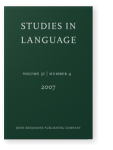Vol. 31:4 (2007) ► pp.721–764
Constructing grammatical meaning
Isomorphism and polysemy in Czech reflexivization
In a usage-based analysis of four syntactic reflexives in Czech, this paper examines the question of representing speakers’ knowledge of polyfunctional grammatical categories. I argue that the reflexives form a prototype-based network of partially overlapping grammatical patterns, organized by the pragmatic concept of unexpected referential status in agent–patient relations. This concept is manifested in four distinct communicative functions: marking referential identity between agent and patient roles; distancing discourse participants from their involvement in the reported event; recasting a transitive event as a spontaneous change of state; expressing an attitude toward the reported event. Each function is shown to conventionally co-occur with a set of properties involving various combinations of the following: preferences in aspect and transitivity; semantic and/or pragmatic constraints on agents and patients; verb semantics; shifts in modality and pragmatic force; morphosyntactic constraints. Overall, the analysis supports the view that grammatical categories cannot be properly defined outside of broader grammatical context, thus arguing for a constructional approach to linguistic structure and for re-interpreting the principle of isomorphism in terms of ‘constructions’ in the sense of Construction Grammar.
Cited by
Cited by 15 other publications
This list is based on CrossRef data as of 14 april 2024. Please note that it may not be complete. Sources presented here have been supplied by the respective publishers. Any errors therein should be reported to them.
